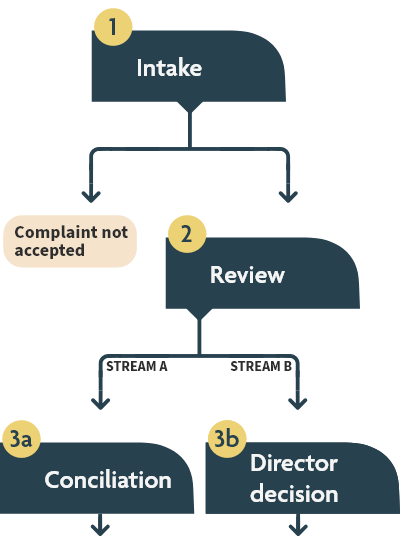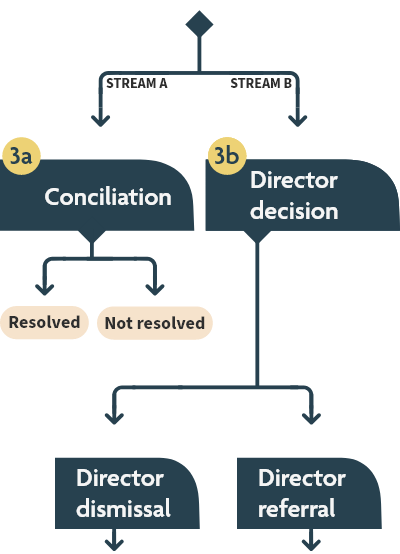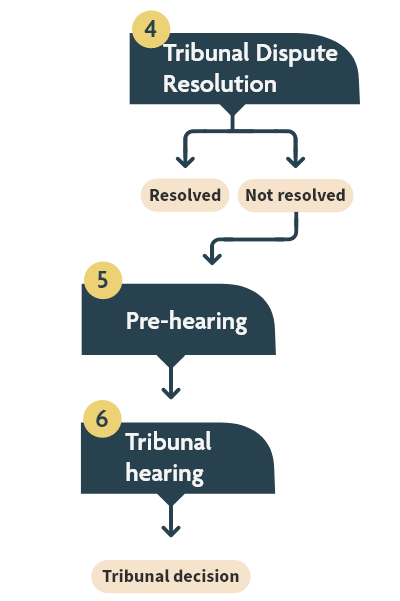
Complaint Process
Complaint Resolution
Guiding principles for the complaint process:
- strive to close as many complaints as we receive in a year
- resolve complaints in a timely, effective, and fair manner
- address public interest issues, including systemic discrimination
- learn from past projects and processes to streamline steps, emphasize conciliation, maintain firm deadlines, and use specialized teams.
Next Steps
Intake
Complaint forms are available at albertahumanrights.ab.ca/forms. A specialized Intake Team will assess submitted forms. Anyone submitting a form may be asked to provide additional information within 30 days.
Review
If accepted, the complaint is sent to the respondent. The complainant gets a copy of their response. The Intake Team may ask for additional information. The complaint is then assigned to one of two streams.
Complaint not accepted
The potential complainant will receive a letter of explanation and can request a reconsideration.
Conciliation
Most complaints will go to the conciliation stream. Conciliation is a non-adversarial way to resolve complaints. The complainant and respondent will be assigned a date to participate in a private video conference, led by a human rights officer. The officer will explain human rights law and the issues in the complaint to help the parties reach a resolution.
Not resolved
If the complaint is not resolved the complaint is sent for a Director decision (step 3, stream B)
Director decision
A Decision Team will request further information, if necessary. Based on the Alberta Human Rights Act, a decision will be made on whether complaints should be referred to the tribunal or be dismissed.
Director dismissal
If the Director of the Commission dismisses a complaint, the complainant can request to have the decision reviewed by the Chief of the Commission and Tribunals (this is an appeal).
Director referral
The Director may refer a complaint to the Tribunal.
Tribunal
The Tribunal:
- delivers a quasi-judicial adjudication process under the Alberta Human Rights Act
- is committed to a process that is fair, timely, and accessible to all parties
- is comprised of Members of the Commission, who are neutral decision-makers with knowledge and training in human rights law and issues.
Tribunal
The Tribunal:
- delivers a quasi-judicial adjudication process under the Alberta Human Rights Act
- is committed to a process that is fair, timely, and accessible to all parties
- is comprised of Members of the Commission, who are neutral decision-makers with knowledge and training in human rights law and issues.
Request for review
The complainant submits a request for review of the Directorʼs decision to the Tribunal Office for the Chief of the Commission and Tribunals (the Chief). The respondent gets a chance to respond to the request for review. The Chief reviews the information that the Director considered and the parties submitted for the request. The parties receive the written decision on whether the Chief agreed with the Directorʼs decision. The written decision is published on CanLII.
Chief disagreed
Complaint goes to the Tribunal
Tribunal Dispute Resolution (TDR)
TDR is a confidential and voluntary mediation process. The complainant and respondent have decision-making power in this step. The parties meet through video conference with a Member of the Commission who helps them try to resolve the issues in the complaint.
Pre-hearing
The parties meet with the Tribunal Registrar or a Member of the Commission through teleconference or videoconference to set dates for the hearing and deadlines for hearing submissions.
Before the hearing, parties may also raise other issues specific to the hearing. Parties file hearing submission and exchange them with each other before the hearing.
Tribunal hearing
A Tribunal hearing is adjudicated by one (and in some cases three) Members of the Commission. During a hearing, the complainant and respondent make opening statements, present their cases by asking witnesses questions, and make closing statements. All Tribunal hearings are open to the public.
Tribunal decision
After the hearing, the parties receive the Tribunal's written decision and it is published on the Canadian Legal Information Institute (CanLII) website.
A graphic flow chart version of the complaint process is available.
Complaint Resolution
Guiding principles for the complaint process:
- strive to close as many complaints as we receive in a year
- resolve complaints in a timely, effective, and fair manner
- address public interest issues, including systemic discrimination
- learn from past projects and processes to streamline steps, emphasize conciliation, maintain firm deadlines, and use specialized teams.
Step 1 Intake
Complaint forms are available at albertahumanrights.ab.ca/forms. A specialized Intake Team will assess submitted forms. Anyone submitting a form may be asked to provide additional information within 30 days.
If the complaint is not accepted, the potential complainant will receive a letter of explanation and can request a reconsideration.
Step 2 Review
If accepted, the complaint is sent to the respondent. The complainant gets a copy of their response. The Intake Team may ask for additional information. The complaint is then assigned to one of two streams.
Step 3, Stream A, Conciliation
Most complaints will go to the conciliation stream. Conciliation is a non-adversarial way to resolve complaints. The complainant and respondent will be assigned a date to participate in a private video conference, led by a human rights officer. The officer will explain human rights law and the issues in the complaint to help the parties reach a resolution.
If the complaint is resolved the complaint is closed.
If the complaint is not resolved the complaint is sent for a Director decision (step 3, stream B)
Step 3, Stream B, Director decision
A Decision Team will request further information, if necessary. Based on the Alberta Human Rights Act, a decision will be made on whether complaints should be referred to the tribunal or be dismissed.
If the Director refers the complaint to the Tribunal, the next step is Tribunal Dispute Resolution (step 4).
If the Director of the Commission dismisses a complaint, the complainant can request to have decision reviewed by the Chief of the Commission and Tribunals (this is an appeal).
If the complainant does not request a review the complaint is closed.
Request for review
The complainant submits a request for review of the Director's decision to the Tribunal Office for the Chief of the Commission and Tribunals (the Chief). The respondent gets a chance to respond to the request for review. The Chief reviews the information that the Director considered and the parties submitted for the request. The parties receive the written decision on whether the Chief agreed with the Director's decision. The written decision is published on CanLII.
If the Chief agreed with the Director's decision the complaint is closed.
If the Chief disagreed with the Director's decision the complaint goes to the Tribunal.
Tribunal
The Tribunal:
- delivers a quasi-judicial adjudication process under the Alberta Human Rights Act
- is committed to a process that is fair, timely, and accessible to all parties
- is comprised of Members of the Commission, whoa re neutral decision-makers with knowledge and training in human rights law and issues.
Step 4 Tribunal Dispute Resolution (TDR)
TDR is a confidential and voluntary mediation process. The complainant and respondent have decision-making power in this step. The parties meet through video conference with a Member of Commission who helps them try to resolve the issues in the complaint.
If the complaint is resolved the complaint is closed.
If the complaint is not resolved the complaint goes to a pre-hearing.
Step 5 Pre-hearing
The parties meet with the Tribunal Registrar or a Member of Commission through teleconference or videoconference to set dates for the hearing and deadlines for hearing submissions.
Before the hearing, parties may also raise other issues specific to the hearing. Parties file hearing submission and exchange them with each other before the hearing.
Step 6 Tribunal hearing
A Tribunal hearing is adjudicated by one (and in some cases three) Members of the Commission. During a hearing, the complainant and respondent make opening statements, present their cases by asking witnesses questions, and make closing statements. All Tribunal hearings are open to the public.
After the hearing, the parties receive the Tribunal's written decision and it is published on CanLII.





